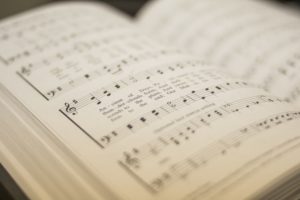The faded blue hymn books lay beneath the baby-grand piano at the sanctuary front, heaped up in two stacks. Their pages were left unopened most of the year – melodies resting muted inside the hard-bound covers – like eager choir members, mouths duct-taped shut. The images linger with me now, as though only five years – not fifty-five – have stolen past.

During my adolescent days I mused now and then over the peculiar ritual of the song books. I’m glad they’re around, but why do they most of the time just sit there, stacked up, hardly ever touched?
“Today, let’s use the song books”. The pastor’s voice was wistful.
Thus, on a random Sunday morning twice or so a year, out the faded books would come. A pair of youngsters were beckoned and the hymnals would get passed along church rows. Shortly the piano’s intro to the tune, “In the Garden“ sounded, followed by “Rock of Ages” or “I’ll Fly Away”. A song penned by a beloved sightless composer named Fanny Crosby, often made the list.
A film of dust had collected on the topmost volumes, as a number of months had passed since the pages last saw daylight.
In those days of the 50’s I hadn’t yet surmised that the faded blue books had become a kind of sentimental relic in our church. The stack of these aged and more formal kind of songs – hymns – remained too near the heart of older believers to see the church completely part with them. Yet, by some undefined standard, it seemed the music in the old blue books lacked a revivalist flavor – of the sort which had recently captured imaginations and vocal chords. The spiritual songs. These were freshly-composed choruses, gaining increased use among independent Pentecostals identified with something called the Latter Rain Movement.
With a musical heritage marked by informal gospel choruses, I grew fond of many of the tunes. Finding myself at times, along with others, immersed in a rich, palpable presence – God’s presence – where sustained, worshipful singing found deep-hearted expression. Such gatherings often left many worshippers reluctant to leave, well after the final dismissal prayer.
Still, as years moved on, an undefined something in the realm of lyric and melody seemed missing. Like an absent-without-leave musical expression specially-tailored to the heart of God-seekers. Then my wife and I moved to Lima, New York in our missionary-candidate season. We stepped into a chapel service at Elim Bible Institute – in the I. Q. Spencer Tabernacle, named for the institute’s founder. That was where it happened.
My soul getting highjacked by the Redemption Hymnal.
©2017 Jerry Lout


You guys were ahead of the game of putting hymn books aside and learning repetitive Praise Songs. We were still singing “Just as I “at that point. In fact we still the hymns in one service. Many have been resurrected as “Praise Hymns” for this generation. Looking forward to the “next chapter”.
Indeed, Lin, I’ve learned through the years there were a number of varying rhythms (pardon the pun) in communities across the landscape. Thanks for the observation.